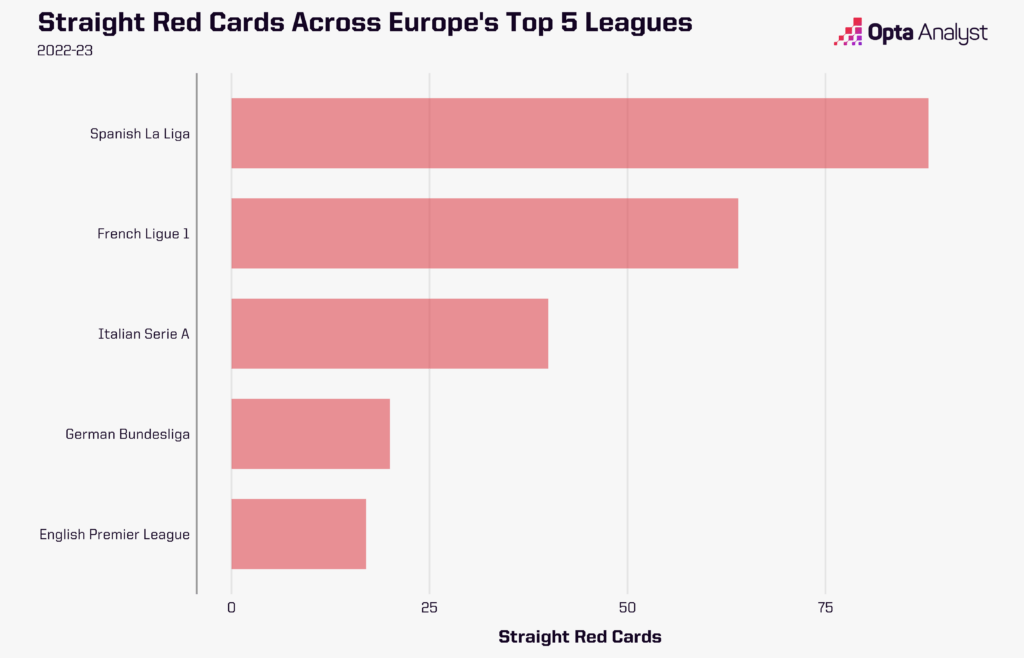La Liga have changed their criteria for what merits a red card. That goes some way to explaining the explosion of dismissals we’ve seen this season in Spain. The league’s own corporate account released a video when the media picked up on this phenomenon to explain what’s happening. In the clip, they said La Liga players had not become more aggressive but that the referees had changed their criteria for what a red card is, thus leading to more red cards in La Liga. They stopped short of explaining what the change was.
There has never been a more difficult time to be a referee in Spain. One official was attacked in a youth game in Ceuta recently and the Spanish Football Federation felt the need to respond to the “climate of hostility that has risen surrounding referees.” Part of the reason is the Negreira case. Barcelona were charged with corruption over payments allegedly made to Jose Maria Enriquez Negreira, the former vice-president of Spanish football’s refereeing committee (CTA), and his son, Javier Enriquez, between 2001 and 2018. Officially, Barca hired the pair to create reports on national team games and referees’ performances, but Negreira held a senior role in the CTA throughout this period and the relationship was only discovered by tax inspectors, who are said to have found €7.2 million worth of payments made by Barcelona. All parties have denied any wrongdoing.
So, although the Negreira case has been a huge scandal in Spain, frustration around the frequency of red cards in La Liga was already a hot topic before that controversy came to light. It has fanned the flames of an already sensitive subject.
It could be argued the referees, for their part, don’t help themselves. The recently retired Antonio Mateu Lahoz set a record for yellow cards in the 2022 World Cup when he carded 17 players during the Argentina versus Netherlands quarter-final. It wasn’t a performance that won him any plaudits.
But officials do have a tough job.
“In Spain, we’re a bunch of cheats,” said Jose Luis Mendilibar when asked about the referee’s management of a game back in 2020-21 when he was coaching Eibar. “They touch us and we go down as if we’ve been killed.”
Essentially, there’s a perception of Spanish football being a hotbed of unsporting conduct and confusion around the rules. All 42 teams in the top two divisions recently answered an official La Liga survey, and all of them agreed no one knew the criteria for handball. 93% of the teams believe there have been too many red cards, and that the number of straight reds doesn’t correlate with the general level of aggression in the league. Then, 78% of the clubs feel the cards are having an adverse effect on the way the game develops.
So, how many red cards have there been?
La Liga’s Red Fury
The bottom line – and a variation of the stat that you may have already seen – is La Liga produced 137 red cards this season. That’s 40 more than any of the other top five European leagues and, incredibly, an increase of 107 – yes, you’ve read that correctly: 107! – on the Premier League (30).
We’ll come back to that wider European data shortly. First, we need to dig into La Liga’s numbers a little more.
It should be highlighted that, despite the ludicrousness of La Liga’s red card figures compared to the other leagues this term, Spain’s top flight isn’t going to break the record for dismissals.
Between the 2005-06 and 2013-14 seasons, La Liga saw at least 110 red cards shown by referees in each campaign, with those figures peaking at 158 in 2006-07. That is the highest figure of any season going back as far as we have the data (2005-06). 137 red cards is the highest number shown since 2009-10.
Red card figures did drop below 100 (95) once between 2005 and 2016, but from the 2016-17 season onwards they’ve been far more controlled, ranging from 67 (2017-18) to 89 (2021-22 and 2019-20). One explanation for those more conservative numbers is potentially the July 2016 rule change by the International Football Association Board (IFAB) around the so-called triple punishment law, whereby players who denied goal-scoring opportunities in the penalty area with accidental fouls were no longer automatically sent off.
But here we are, in 2022-23, and the 137 red cards is 50 more than last term.
Break the Record for Red Cards in La Liga
And the point that really brings home the absurdity of it all is the number of straight red cards: 88. Fair enough, in isolation that figure might not mean much. It’s 40 more than in 2021-22 and is just five more than the 83 recorded in 2006-07, which is as far back as this data was collected. Let’s not forget, that was also in the pre-VAR era, and a time when infamous hard men such as Javi Navarro and Pablo Alfaro were causing havoc.
Straight reds decreased quite dramatically after the 2009-10 (81) season, going no higher than 58 until… you guessed it, this season.
“Ah, but maybe players are just kicking lumps out of each other more often,” we know you’re thinking. Well, it’s untrue. As we noted at the start, even La Liga says that’s not the case. In fact, this 18-year high for reds comes despite foul frequency being at its lowest since at least 2005-06. Back then there were 38.8 fouls per game – this season is averaging 25.9.
Similarly, the average of one red card every 71.8 fouls is the highest frequency – and significantly so – over the period we’ve been looking at, with 81.2 (2009-10) the closest in that regard. The lowest frequency of reds to fouls was in 2017-18 when there was only one red card for every 157.2 fouls.
Whichever way you cut it, 2022-23 has been truly extraordinary on the red cards front in La Liga.
Putting La Liga’s Card-Happy Referees Into Context
To put all of this into context, we must look at the other elite leagues in Europe. Nominally they’re playing the same sport but the rules are being applied in an entirely different way. Despite La Liga saying the league is not more aggressive than in years past, referees intervene at a much higher rate than in any of the top five European leagues. There are 25.9 fouls per game in La Liga compared to 21.6 in the Premier League, which has the lowest number of fouls conceded per game. Eight of the top nine teams with most red cards are Spanish – Real Betis (15), Sevilla (13), Elche (12), Montpellier, Ajaccio, Espanyol (10), Getafe (9), Valencia, Atlético Madrid (8).

The number of fouls conceded per game has not been lower since at least 2005-06 but the straight reds record in that time is set to be beaten. We can see below that the number of straight reds for professional fouls, fouls and fights has taken a significant jump. This is clearly where referees have changed the criteria, and the 88 straight reds in Spain compared to 20 in the Premier League suggests something has gone awry with the application of the rules somewhere along the line.
Anecdotally, La Liga referees are trying to let the game flow more and that is reflected in the fouls per game. But this seems to be working against them because as the game progresses, the players grow more frustrated and, for fear of completely losing control, the referee starts showing cards to anyone who looks at them sideways.
To really understand the “why” of it all, we essentially need La Liga to offer specifics. It says the criteria for reds was changed, but why? What was the criteria before and what is it now?
As the numbers show, something isn’t quite right. The ratio of red cards per foul is extremely high, and on a general note regarding on-pitch decisions, there’s no doubt that uncertainty is rife.
Pepe Castro, the president of Sevilla, summed up the confusion neatly: “If all the teams are complaining, then there’s something to it. There are times when nobody knows if they’re going to whistle a foul or not. The handballs, the intention behind it… and the thing with the cards and the lack of criteria doesn’t make any sense.”
In an interview with AS, CTA chief, Luis Medina Cantalejo, explained the increase in red cards as referees exercising their “obligation to protect the player as an athlete and as the main asset that football teams have,” which certainly sounds noble enough. But then surely we’d expect an increase in fouls rather than a dramatic decrease?
Either way, La Liga president Javier Tebas last month acknowledged a need to “address without confrontation” the increase in dismissals, which should be as clear a sign as any that something’s amiss.
Enjoy this? Subscribe to our newsletter to receive five stories each Friday. It’s free. And follow us on Twitter too.
